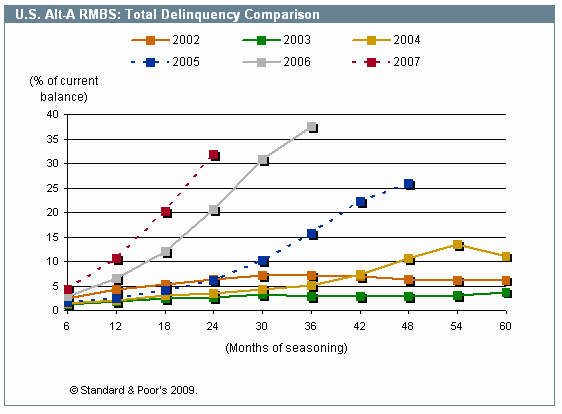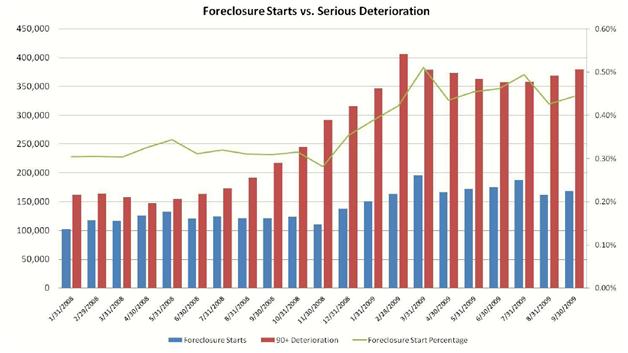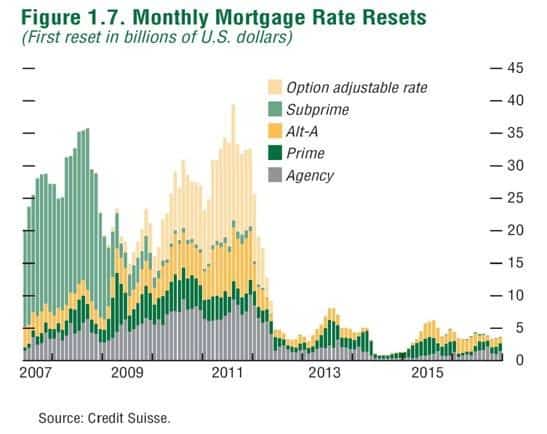Strategic default: In come the waves again
John Hussman notes that the very large non-subprime Alt-A and Option ARM cohort interest-rate resets lie ahead of us and not behind us in his latest weekly market commentary. In my view, this is a very big problem for the US banking sector and economy because of the credit writedowns these resets will generate.
For his part, Hussman says:
I should note parenthetically that as you read reports about the mortgage and credit markets during the next few months, it will be extremely important to pay attention to the time period being discussed. For example, we are seeing articles with very recent datelines that are drawing conclusions based on relatively pleasant data from the fourth quarter of last year, which reflects the end of the reset lull that was completed with the low in September.
To reiterate what the reset curve looks like here, the 2010 peak doesn’t really get going until July-Sep (with delinquencies likely to peak about 3 months later, and foreclosures about 3 months after that). A larger peak will occur the second half of 2011. I remain concerned that we could quickly accumulate hundreds of billions of dollars of loan resets in the coming months, and in that case, would expect to see about 40% of those go delinquent based on the sub-prime curve and the delinquency rate on earlier Alt-A loans. Notably, by 2005, the credit score allowed on Alt-A loans fell to about 620, which is consistent with sub-prime. And not surprisingly, the later in the housing bubble the loan was made, the higher the delinquency rate has been right out of the gate.
The earliest data we will observe in terms of Alt-A and Option-ARM loans will be driven by the relatively small initial round of resets that began in November of last year. That implies that any data prior to February is relatively clean of these effects. What we are interested in is the extent to which we observe a spike in 30-day delinquencies in data beginning about the February-March time frame. The size of the delinquency effects is likely to increase through the year, back off in the first half of 2011, and then reach their final peak in late 2011.
Emphatically, we do not need to work through the whole reset cycle in order to accept market risk. But significant damage in the stock market is often taken in the "recognition phase" where troubling reality departs from optimistic expectations. On that front, I am doubly concerned here because on the basis of an ensemble of fundamental measures (normalized earnings, revenues, book values, dividends), the only points between the pre-Depression period and the late-1990’s when the market has been so richly valued were November-December 1972 (before a 2-year market loss of about 50%), and August-September 1987. The hostile yield trends I noted last week (The Rubber Hits the Road) only amplify that concern.
This is something I am on to and have mentioned a few times in the past few months. As I wrote last month in The coming wave of second mortgage writedowns:
When the crisis first developed, in February of 2007, it was subprime where the worries were, with the lion’s share of writedowns coming from mark-to-market losses in the securitisation market. However, subprime was a relatively small part of the overall market, making up 14% of loans outstanding at that time. Alt-A loans were 27% and prime loans were 57% respectively of loans outstanding according to a Banc of America Securities report.
As the 2004-2007 cohorts of Alt-A option ARM mortgages have started to reset and prime borrowers have come under stress, we have started to see defaults in markets which are an order of magnitude larger than subprime.
The same dynamics will be at play here that were at play during the meltdown in subprime, except this time we are talking mainly about prime borrowers. Remember, this is and has always been a credit crisis, not a subprime mortgage crisis. It is the result of lax regulation, easy money and lending recklessness on a mammoth scale that goes far beyond subprime. Hussman makes the same point when he quips:
it should be evident that the recent credit crisis did not emerge as some unpredictable surprise, but was instead the very ordinary outcome of extraordinary recklessness. Though the mounting problems in 2005 were utterly ignored by the stock market for more than two years after this analysis was published, the fact is that even with the recent rebound, the S&P 500 remains below where it was in mid-2005. Overvaluation and reckless lending do not always translate into near-term market weakness, but they invariably haunt investors in the form of poor long-term returns.
The interesting bit for me is he leads into this via a quote from a five-year old piece from the Economist which way back in 2005 predicted calamity for the global housing bubble that had already formed. This is the very same article I referenced in June 2008 when I wrote Naysayers, the housing bubble was obvious as the housing bubble was beginning to unravel in the U.S.
The Economist said presciently:
Interest-only mortgages are all the rage, along with so-called ‘negative-amortisation loans’ (the buyer pays less than the interest due and the unpaid principal and interest is added on to the loan). After an initial period, payments surge as principal repayment kicks in. In California, over 60% of all new mortgages this year are interest-only or negative-amortisation, up from 8% in 2002. The national figure is one-third. The new loans are essentially a gamble that prices will continue to rise rapidly, allowing the borrower to sell the home at a profit or refinance before any principal has to be repaid.
And when prices stopped rising, homeowners defaulted on a massive scale. The carnage spread in the financial sector most quickly via huge losses in marked-to-market mortgage backed-securities (MBS) and collateralised debt obligations (CDOs). However, when the mark-to-market rules allowed for greater ‘discretion’ in designating these derivatives as hold-to-maturity assets, financial institutions got a free pass and are now hiding hundreds of billions in writedowns this way. This was a huge boon for financial shares, which have increased markedly ever since. See Wells profit forecast is a clear bullish sign.
The difference going forward has to do with strategic defaults. When a delinquent mortgagee runs into problems, a bank servicer has a lot of discretion in the way it can deal with this situation. Inevitably, this leads mortgage lenders to extending and pretending the delinquency is temporary. However there is a growing divide between delinquencies and foreclosures, which suggests that foreclosure data understate the mortgage distress and delinquencies now building in the U.S. residential housing market.
When Option-ARM and Alt-A interest rates re-set higher, payments will increase dramatically for many borrowers who are hopelessly underwater on their mortgages. This will be a significant driver of defaults in 2010 and 2011.
Moreover, a recent article in the New York Times demonstrates that borrowers with high FICO scores are still at risk of default, opting to pay credit cards off instead of mortgages.
This is all pointing to a coming wave of strategic defaults. Borrowers whose homes are significantly underwater could be looking at losses at sale for up to 6 years. Therefore, many are opting to default strategically. When a borrower defaults and walks away, the loss becomes unrecoverable and the value of the asset must be written down. So while holding MBS paper to maturity has cushioned banks to date, a large wave of strategic defaults would pressure lenders who are under-provisioning for future losses.
Expect this to play out over 2010 and 2011.
Sources
Ordinary Outcomes of Extraordinary Recklessness – John Hussman
In come the waves ($) – Economist, 16 Jun 2005



Comments are closed.